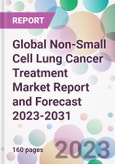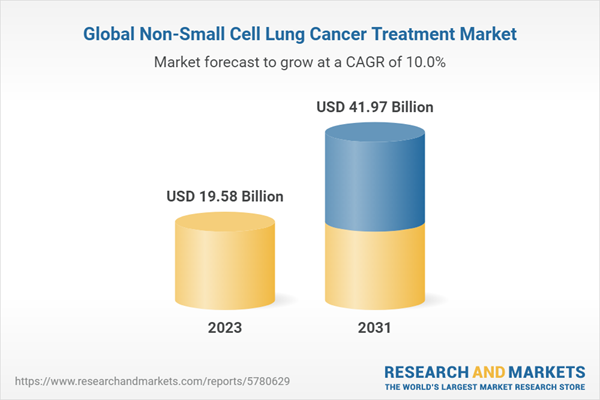The global non-small cell lung cancer treatment market size was estimated to be worth USD 17.8 billion in 2022. The market is likely to grow at a rate of 10% during the forecast period of 2023-2031. Driven by the growing demand for diagnostics and therapeutics, the market is anticipated to be worth USD 41.97 billion by 2031.
The report provides a comprehensive analysis of the non-small cell lung cancer treatment market, including market size, growth, and trends. NSCLC is a type of lung cancer that affects the epithelial cells of the lungs. The disease is responsible for a significant proportion of lung cancer-related deaths globally. The report covers the market for NSCLC treatment, including drugs and therapies used for the treatment of NSCLC.
The five-year survival rate for NSCLC depends on the stage of the disease at diagnosis, with early-stage disease having a better prognosis than advanced-stage disease. Overall, the five-year survival rate for NSCLC is approximately 24%, although this varies widely depending on the stage of the disease.
The incidence of NSCLC varies widely across the world, with the highest rates seen in developed countries with high rates of smoking, such as the United States, Europe, and Japan. In contrast, the incidence of NSCLC is lower in developing countries, although it is increasing as smoking rates and environmental pollution levels rise.
As the global population continues to age and smoking rates remain high in many parts of the world, the prevalence of NSCLC is expected to continue to rise in the coming years. This is expected to drive the growth of the NSCLC treatment market, as healthcare providers seek new and innovative therapies to manage this deadly disease.
North America dominates the NSCLC treatment market, followed by Europe and Asia Pacific. The high prevalence of NSCLC in North America, coupled with the favourable reimbursement policies, is driving the growth of the market in the region. Europe is also a significant market for NSCLC treatment, with the presence of key players and increasing investment in research and development activities. The Asia Pacific region is expected to grow at the highest CAGR during the forecast period, owing to the increasing awareness about the disease and the rising healthcare expenditure in the region.
The market for NSCLC treatment can be categorized into various segments, including drug type, therapy type, and distribution channel. The most used drug types for NSCLC treatment include chemotherapy, immunotherapy, targeted therapy, and others. The therapy type segment can be further categorized into surgery, radiation therapy, and others. In terms of distribution channel, the market can be segmented into hospital pharmacies, retail pharmacies, and online pharmacies.
Non-Small Cell Lung Cancer Treatment Market: Introduction
The market is expected to grow significantly during the forecast period of 2023-2031, driven by the rising prevalence of non-small cell lung cancer (NSCLC) across the globe and the increasing investment in research and development activities. NSCLC is a type of lung cancer that accounts for approximately 85% of all lung cancer cases. The disease is caused by the uncontrolled growth of abnormal cells in the lung tissue, which can spread to other parts of the body. There are various treatment options available for NSCLC, including surgery, radiation therapy, chemotherapy, targeted therapy, and immunotherapy.The report provides a comprehensive analysis of the non-small cell lung cancer treatment market, including market size, growth, and trends. NSCLC is a type of lung cancer that affects the epithelial cells of the lungs. The disease is responsible for a significant proportion of lung cancer-related deaths globally. The report covers the market for NSCLC treatment, including drugs and therapies used for the treatment of NSCLC.
Non-Small Cell Lung Cancer Epidemiology
Non-small cell lung cancer is a leading cause of cancer-related deaths worldwide, with an estimated 1.8 million new cases diagnosed annually. The disease is more common in men than women and is strongly associated with smoking. Other risk factors include exposure to environmental pollutants and a family history of lung cancer. NSCLC is typically diagnosed in patients aged 65 or older, although it can occur at any age.The five-year survival rate for NSCLC depends on the stage of the disease at diagnosis, with early-stage disease having a better prognosis than advanced-stage disease. Overall, the five-year survival rate for NSCLC is approximately 24%, although this varies widely depending on the stage of the disease.
The incidence of NSCLC varies widely across the world, with the highest rates seen in developed countries with high rates of smoking, such as the United States, Europe, and Japan. In contrast, the incidence of NSCLC is lower in developing countries, although it is increasing as smoking rates and environmental pollution levels rise.
As the global population continues to age and smoking rates remain high in many parts of the world, the prevalence of NSCLC is expected to continue to rise in the coming years. This is expected to drive the growth of the NSCLC treatment market, as healthcare providers seek new and innovative therapies to manage this deadly disease.
NON SMALL CELL LUNG CANCER TREATMENT Market Segmentations
The market can be categorised into type, treatment type, drug class, therapy type, distribution channel, and end user.Market Breakup by Type
- Adenocarcinoma
- Squamous Cell Carcinoma
- Large Cell Carcinoma
- Others
Market Breakup by Treatment Type
- Immunotherapy
- Chemotherapy
- Radiation Therapy
- Targeted Therapy
- Others
Market Breakup by Drug Class
- Alkylating Agents
- Epidermal Growth Factor Receptor Blocker
- Antimetabolites
- Mitotic Inhibitors
- Multi-kinase Inhibitors
- Others
Market Breakup by Therapy Type
- Single Drug Therapy
- Combination Therapy
Market Breakup by Distribution Channel
- Hospital Pharmacies
- Retail Pharmacies
- Online
- Others
Market Breakup by End User
- Hospitals
- Homecare
- Specialty Clinics
- Others
Non Small Cell Lung Cancer Treatment Market Breakup by Region
North America
- United States of America
- Canada
Europe
- United Kingdom
- Germany
- France
- Italy
- Others
Asia Pacific
- China
- Japan
- India
- ASEAN
- Australia
- Others
Latin America
- Brazil
- Argentina
- Mexico
- Others
Middle East and Africa
- Saudi Arabia
- United Arab Emirates
- Nigeria
- South Africa
- Others
Non-Small Cell Lung Cancer Treatment Market Scenario
The market is expected to experience significant growth during the forecast period of 2023-2031. The key drivers of the market include the increasing prevalence of NSCLC, growing awareness about the disease, and advancements in medical technology. In addition, the rising demand for personalized medicine and targeted therapies is expected to further boost the market growth.North America dominates the NSCLC treatment market, followed by Europe and Asia Pacific. The high prevalence of NSCLC in North America, coupled with the favourable reimbursement policies, is driving the growth of the market in the region. Europe is also a significant market for NSCLC treatment, with the presence of key players and increasing investment in research and development activities. The Asia Pacific region is expected to grow at the highest CAGR during the forecast period, owing to the increasing awareness about the disease and the rising healthcare expenditure in the region.
The market for NSCLC treatment can be categorized into various segments, including drug type, therapy type, and distribution channel. The most used drug types for NSCLC treatment include chemotherapy, immunotherapy, targeted therapy, and others. The therapy type segment can be further categorized into surgery, radiation therapy, and others. In terms of distribution channel, the market can be segmented into hospital pharmacies, retail pharmacies, and online pharmacies.
Key Players in the Global Non-Small Cell Lung Cancer Treatment Market
The report gives an in-depth analysis of the key players involved in the Non-Small Cell Lung Cancer Treatment market, sponsors manufacturing the drugs, and putting them through trials to get FDA approvals. The companies included in the market are as follows:- Genentech, Inc. (F Hoffmann-La Roche Ltd)
- Eli Lilly and Company
- Celgene Corporation (Bristol-Myers Squibb Company)
- Pfizer Inc
- AstraZeneca
- Sanofi
- Novartis AG
- Astellas Pharma Inc
- Boehringer Ingelheim International GmbH
- Merck & Co. Inc
- Takeda Pharmaceutical Company Limited
- Clovis Oncology
- Johnson & Johnson Services, Inc
- Teva Pharmaceutical Industries Ltd
Table of Contents
1 Preface
3 Non-Small Cell Lung Cancer Overview
4 Patient Profile
5 Non-Small Cell Lung Cancer Epidemiology Analysis
6 Global Non-Small Cell Lung Cancer Treatment Market Overview
7 Global Non-Small Cell Lung Cancer Treatment Market Landscape
8 Non-Small Cell Lung Cancer : Challenges and Unmet Needs
10 Global Non-Small Cell Lung Cancer Treatment Market Dynamics
11 Global Non-Small Cell Lung Cancer Treatment Market Segmentation
12 North America Non-Small Cell Lung Cancer Treatment Market
13 Europe Non-Small Cell Lung Cancer Treatment Market
14 Asia Pacific Non-Small Cell Lung Cancer Treatment Market
15 Latin America Non-Small Cell Lung Cancer Treatment Market
16 Middle East and Africa Non-Small Cell Lung Cancer Treatment Market
17 Regulatory Framework
18 Patent Analysis
19 Grants Analysis
20 Clinical Trials Analysis
21 Funding and Investment Analysis
22 Partnership and Collaborations Analysis
23 Supplier Landscape
24 Non-Small Cell Lung Cancer Treatment - Distribution Model (Additional Insight)
26 Company Competitiveness Analysis (Additional Insight)
27 Payment Methods (Additional Insight)
Companies Mentioned
- Genentech, Inc. (F. Hoffmann-La Roche Ltd)
- Eli Lilly and Company
- Celgene Corporation (Bristol-Myers Squibb Company)
- Pfizer Inc.
- AstraZeneca
- Sanofi
- Novartis AG
- Astellas Pharma Inc.
- Boehringer Ingelheim International GmbH
- Merck & Co. Inc.
- Takeda Pharmaceutical Company Limited
- Clovis Oncology
- Johnson & Johnson Services, Inc.
- Teva Pharmaceutical Industries Ltd.
Methodology

LOADING...
Table Information
| Report Attribute | Details |
|---|---|
| No. of Pages | 160 |
| Published | April 2023 |
| Forecast Period | 2023 - 2031 |
| Estimated Market Value ( USD | $ 19.58 Billion |
| Forecasted Market Value ( USD | $ 41.97 Billion |
| Compound Annual Growth Rate | 10.0% |
| Regions Covered | Global |
| No. of Companies Mentioned | 14 |









